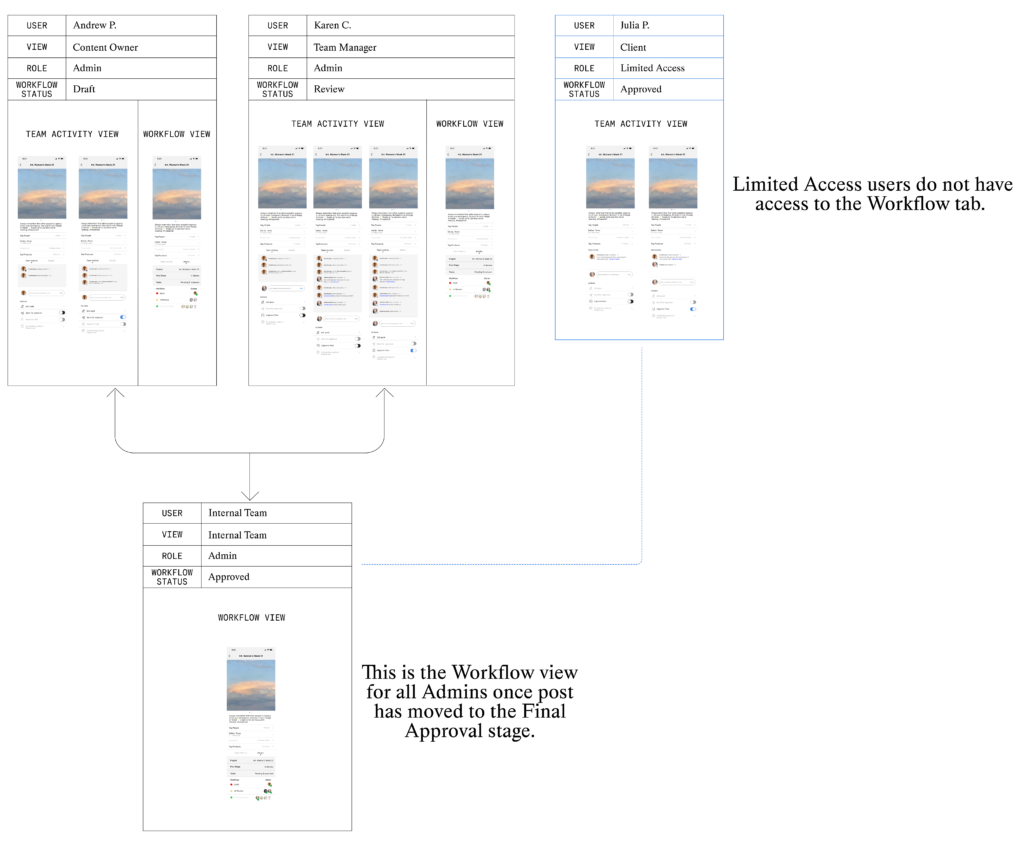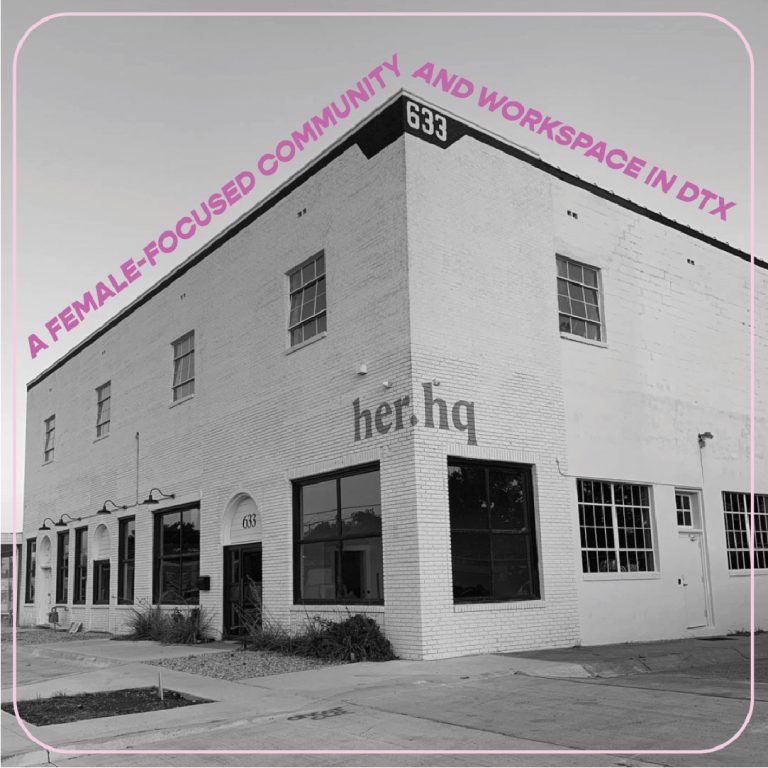UX Case Study
Creating A Workflow Feature for Teams on Facebook Business Suite

Facebook Business Suite is a consolidated content management platform, that allows businesses to manage their Facebook and Instagram channels from a single platform, accessible via desktop or a mobile app. As a professional digital marketer with over 7 years’ experience in agency, corporate, startup, and freelance environments, I’ve seen and done it all when it comes to the social media planning process and team workflows.
For this project, I led the ideation, strategy, and design for a new workflow feature to allow internal and external teams to seamlessly communicate and approve Facebook and Instagram content all in one place.
Disclaimer: I do not work for Facebook. As a freelance UX Designer, I took on this challenge because I’m passionate about social media and design.
My Role
User Research Journey Mapping Wireframing Screen Flows Visual Design
Process
Design Sprint
Timeline
Two Weeks
Project Overview
The Brief
In September 2020, Facebook launched Facebook Business Suite on desktop and through a mobile app. The platform is a combination of a few different Facebook products – Page Manager, Creator Studio, and Business Manager. It is a place for businesses to view key updates and priorities post insights, create ads, manage messages, and draft & schedule feed posts for both Facebook and Instagram. As a professional digital marketer with over 7 years of experience in agency, corporate, startup, and freelance environments, I’ve seen it all when it comes to the social media planning process and team workflows. From sending screenshots via email to after-hours texts from clients to all the content planning platforms I’ve tried truly tried it all. In various attempts to streamline the social media process, what I’ve discovered is that no one wants, or has the time, to be hopping between different platforms. This broken process typically leads to the user back to whatever method is easiest and familiar – a ping on text, email, slack, etc.
The Problem
For the Users
The content planning process typically involves multiple teams, platforms, and software before publishing a single piece of content. This results in an increase of employee hours dedicated to this process, which means increased costs and room for error.
For Facebook
Lack of clarity on the differentiation between Facebook products as well as complex UI is resulting in users moving away from Facebook and resorting to simpler third-party apps and programs for content ideation, planning, scheduling, management, and reporting.
The Opportunity
Add communication and workflow approval capabilities to Facebook Business Suite to increase product usage across the content planning phase and satisfy market demand.
Redesign Goal
Make Facebook Business Suite the all-in-one go-to choice for marketers to seamlessly manage their Facebook and Instagram channels from start to finish.
My process started with a simple question for the user – what does your social media planning and publishing process look like?
I wanted to get a clear picture of how social media teams across a variety of business types and sizes are structured and what their current processes look like. My goal was to better understand the teams behaviors and pain points. Here are some research methods I used for the redesign.
App Store Reviews
The Apple Store and Google Play market currently have over 41K and 1.8M user reviews, respectively. Sifting through hundreds of reviews and complaints, I was able to identify the challenges and opportunities for the platform.
Interviewing The Users
I interviewed six women who are involved in the management of a social media channel or multiple channels on a day-to-day basis – either within an organization, for their own business, or in some cases, both. I prepared the script, scheduled the calls, and conducted the tests.

Research Insights
- Users could not complete the entire ideation, planning, scheduling, approval, live content, and ads management process on Facebook Business Suite. Typically, a team usually requires a minimum of 3 different third-party platforms, leading to a fragmented experience.
- With all the different platforms being used, it’s difficult to track changes and activity made to content and workflow status – this creates an annoying back-and-forth process for teams.
- Clients and executive decision-makers get overwhelmed with a complicated approval process, they are looking to quickly scan the information and approve or provide feedback.
- Flexibility is key. It’s more common than not for a social media team to make quick decisions and last-minute changes to planned content due to crisis management and cultural events.
Based on the data I gathered from the interviews, I was able able to organize my observations and categorize them using an affinity map to give me an idea of the design direction I should take.
User Themes
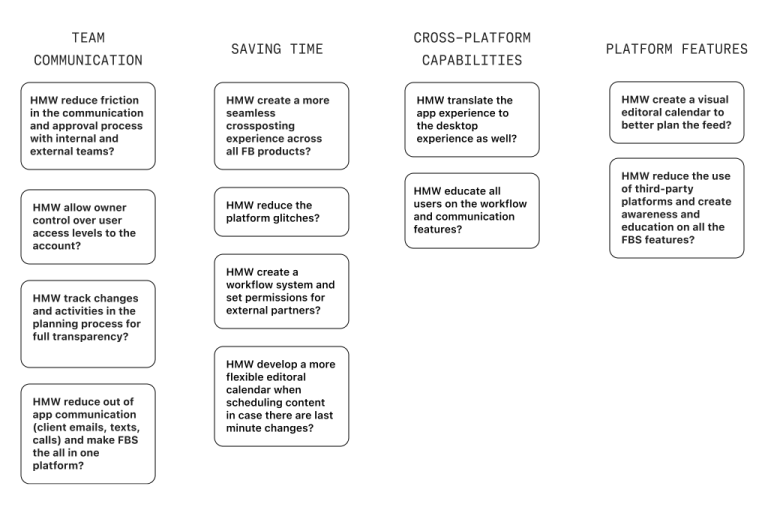
The Content Planning Journey
Using the information from the affinity mapping exercise I put together a user journey map to help me understand the user touchpoints. The user map helped me identify three design challenges and opportunities within the planning to publishing process:
HMW
reduce friction in the communication and approval process with internal and external teams?
HMW
reduce the use of third-party platforms and create awareness and education on all the FBS features?
HMW
track changes and activities in the planning process for full transparency?
I identified that the friction lied in the middle of the content planning process. The opportunity for Facebook Business Suite was to add workflow approval and communication capabilities to increase product usage across the content planning phase and satisfy market demand.

After understanding the current planning and publishing flows and journey for social media teams, as well as their business goals, I set out to sketch out my design solutions for the Facebook Business Suite that could be applied to these three challenges. After countless sketches and iterations I landed on two key ideas:
Team Workflow
At the start of the home screen, you’ll see all your posts and team task reminders. The “Team Workflow” will drive the users to the team’s communication inbox for all Instagram and Facebook content. The final frame shows the activity and communication for an unpublished post.
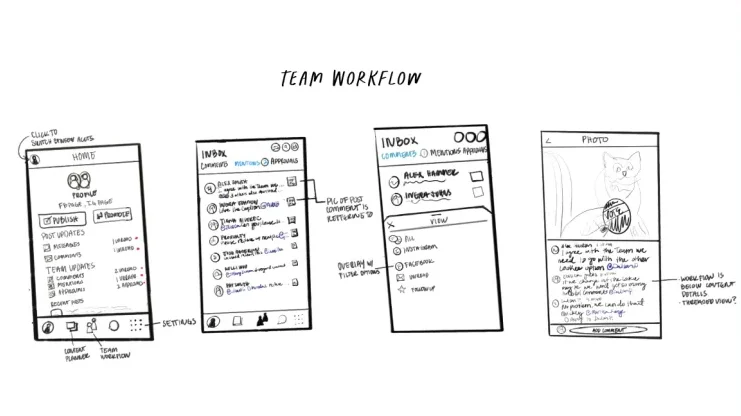
Role Assignment Setup
Not all content or campaigns need the same level of approval. Allow the user who is planning the content the option to assign the team flows and approval workflow from the start.
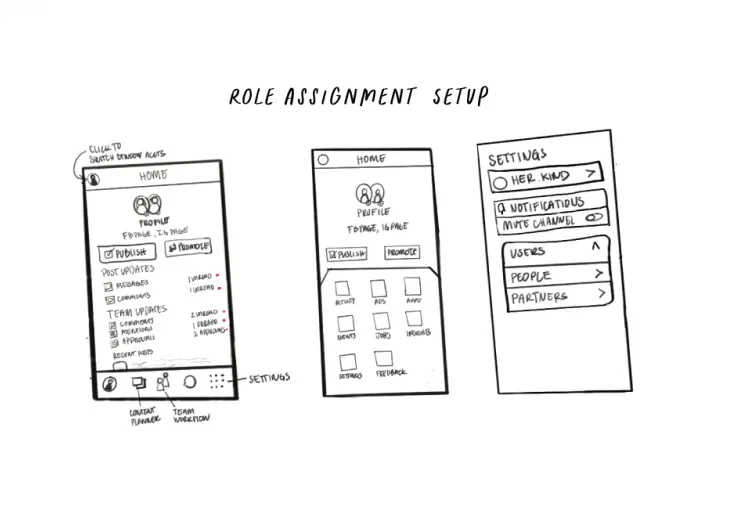
I focused on prototyping the Permission Setting and Team Communication features. I used my proven hypothesis points as guidelines when building out the proposed features.
Hypothesis #1 – Permission Setting
Teams want control over user access levels and permissions for quick decision making and account management.
Permission settings for the general account are located in the settings section. Page admins are able to add, remove, and set each user’s permission level.
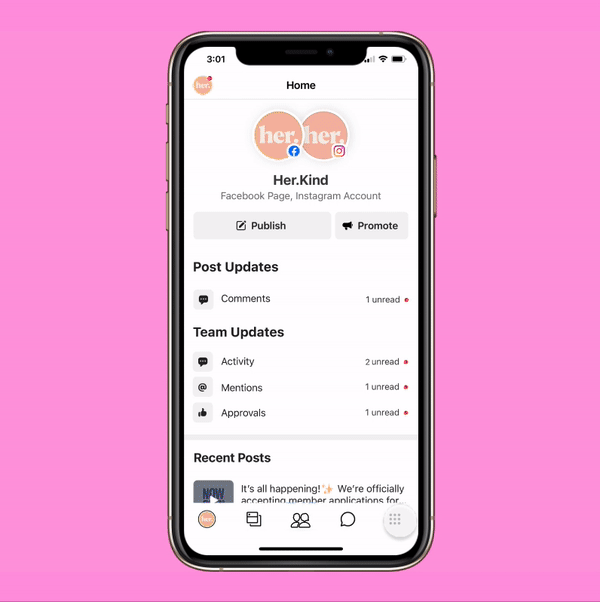
Hypothesis #2 – Team Communication
Teams want to seamlessly communicate and track activities and tasks with internal and external partners for an efficient workflow.
The team’s workspace page gives users the ability to comment, track changes, and see activities in a streamlined work process. The content view is dependant on the user’s permission setting.
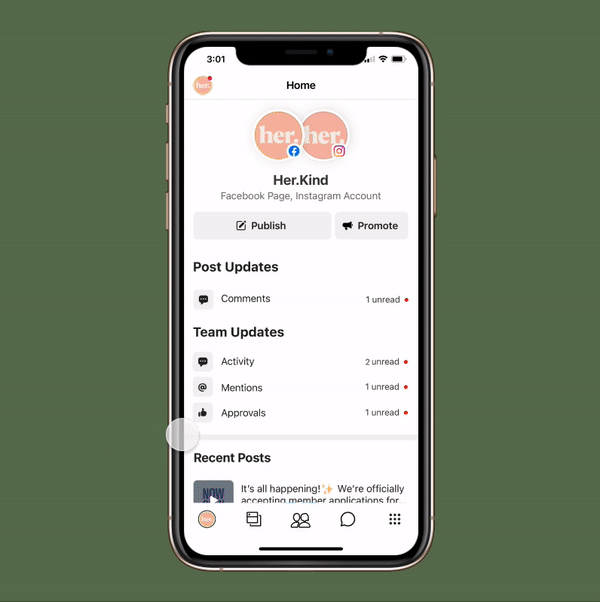
I identified 5 new target users, led recruitment and scheduling, and drafted a research script to ensure I gathered high-quality and unbiased feedback about the effectiveness, marketability, and usability of the new features.
Permission Setting Results
- 3/5 users felt the feature would be helpful for their planning process and team communication.
- Feedback: Users interviewed felt that there was too much information displayed on the activity screen that would most likely not be used often, if at all.
- Opportunity: Reconsider where the information is displayed and simplify the actions for the user.

Team Communication Results
- 2/5 users felt the feature would be beneficial and streamline communication with their team and clients
- Feedback: Users understood the feature but did not feel like it was seamless, felt clunky
- Opportunity: Rethinking through the user flow and UI. How does it look for the internal admin team vs. the client with limited access?

After reviewing the findings from my user tests, I wanted to iterate my prototype to address the feedback. Here are the iteration questions and decisions we made for each feature.
Permission Setting
HMW allow content owners to control and customize permission settings on a case-by-case basis?
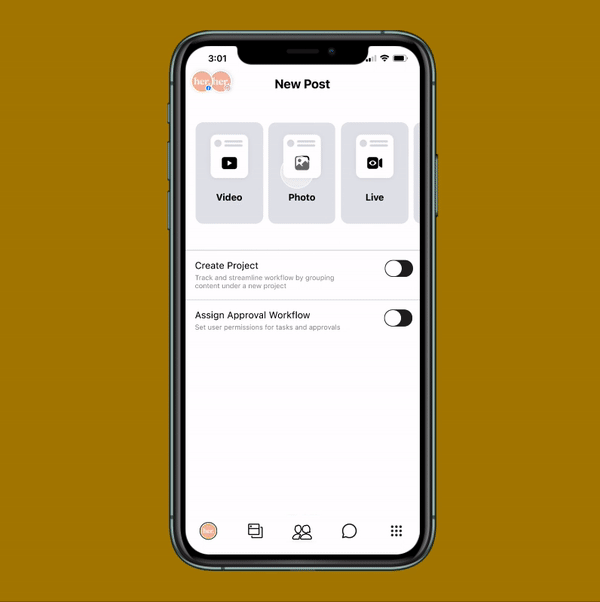
- Not all content or campaigns need the same level of approval. The iteration update gives the users the option to set up roles and workflow approval by pieces or groups of content in the beginning of the content planning phase
- Post functionalities for each user are based on their workflow status the content owner sets
- Roles are split into two different categories – Admin and Limited Access. Workflow options are divided up into three different phases – Draft, Review, and Approved.
- Admin: Perform any action on the content calendar, edit and update unpublished content, view all team activity and view content performance, and manage campaign roles. This is the most access you can grant.
- Limited Access: Limited view on content performance, limited content calendar view – user will only see copy and images but cannot make any edits. Users will be able to make comments but will not be able to see teams activities and comments.
- Draft: Content is WIP, not ready for it’s first round of reviews
- Review: Content is ready to be reviewed and will need to be signed off by the the first round of decision makers assigned (i.e. Social Media Manager, VP of Digital, Project Manager, etc.)
- Approved: Content is signed off by the final group of decision makers and is ready for to be scheduled or published (i.e. content partner or influencer, CEO, agency partner, etc.)
Team Communication and Workflow
HMW allow users to easily and intuitively track changes and see post activity information?
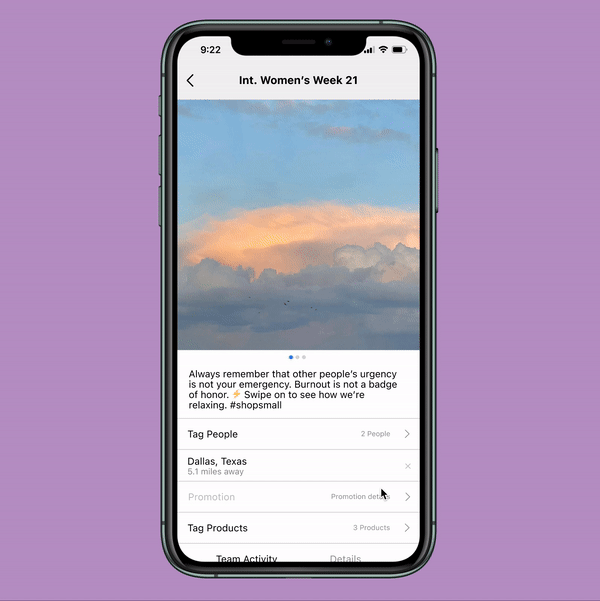
- In the iteration, I added the workflow status within the individual post view – besides the team activity screen
- Team activities, communication and workflow information has been consolidated into the post view, this prevents teams from being overloaded by unrelated information
Key Learnings
- All users saw the value in the updated permission setting feature. They unanimously felt it was “easy, intuitive and useful” and would significantly improve team and client communication.
- The users universally agreed and stated that the team communication and post activities felt clean, easy to follow, and use. They found it helpful to see both admin and client views, to give an understanding of how it functions. They all believed this feature would significantly reduce back-and-forth communication.
- Cross-platform usability is crucial for many users. For my next iteration, I will create the desktop and tablet view.
Conclusion
At the start of the project, with my background and knowledge of the space, I assumed it would be easy to come up with a simple feature to solve the workflow situation. I didn’t anticipate how long and complicated the redesign process would turn out to be.
The biggest challenge for me was scaling back on the feature and functions. My idea was definitely challenged in the first iteration as people questioned every word, feature, and flow, but this feedback allowed me to rework my initial prototype to create a useful and thoughtful design that solves a problem.

